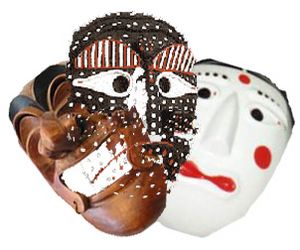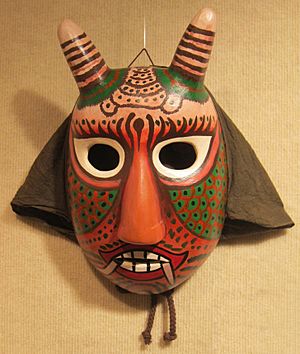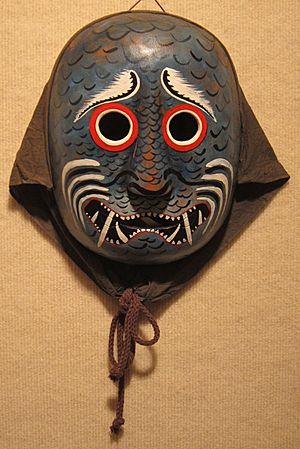Korean mask facts for kids
| Korean mask | |
 |
|
Quick facts for kids Korean name |
|
|---|---|
| Hunminjeongeum |
탈
|
| Hanja |
倛
|
| Revised Romanization | tal |
| McCune–Reischauer | t'al |
Korean masks are special masks from Korea with a very long history. In Korean, any type of mask is called tal. But they also have other names like gamyeon, gwangdae, chorani, talbak, and talbagaji. These masks often have black cloth attached to their sides. This cloth covers the back of the head and makes it look like black hair.
Contents
Why Were Korean Masks Used?
Korean masks were used for many different reasons. Long ago, they were even used in wars by soldiers and their horses! People also used them in special ceremonies. For example, they were part of burial rites. They also helped in shamanistic ceremonies to scare away bad spirits. Some masks were made to remember important historical figures.
Masks were also very important in the arts. They were used in traditional dances and plays. Today, you can find miniature masks as souvenirs for tourists. People even hang them on cell phones as good-luck talismans.
We can think of Korean masks in two main groups. There are religious masks and artistic masks. Religious masks were often used to protect people from evil spirits. Artistic masks were mostly used in dances and theater shows.
Masks for Dance
There are about 250 different kinds of masks used for dancing in Korea. They come in many shapes and styles. Masks from the central part of Korea often look beautiful and similar to human faces. But masks from the southern provinces are often used for satire (making fun of things) and special ceremonies.
Shamanistic Masks and Their Look
Some Korean masks look scary or even ugly. These were used in shamanistic practices. They helped to create a feeling of fear or humor during special ceremonies. Many of these masks were made from alder wood. They were covered with several layers of lacquer to make them shiny and waterproof. The masks were also painted with bright colors. Some even had hinges so the mouth could move!
Images for kids
See also
 In Spanish: Máscaras coreanas para niños
In Spanish: Máscaras coreanas para niños








